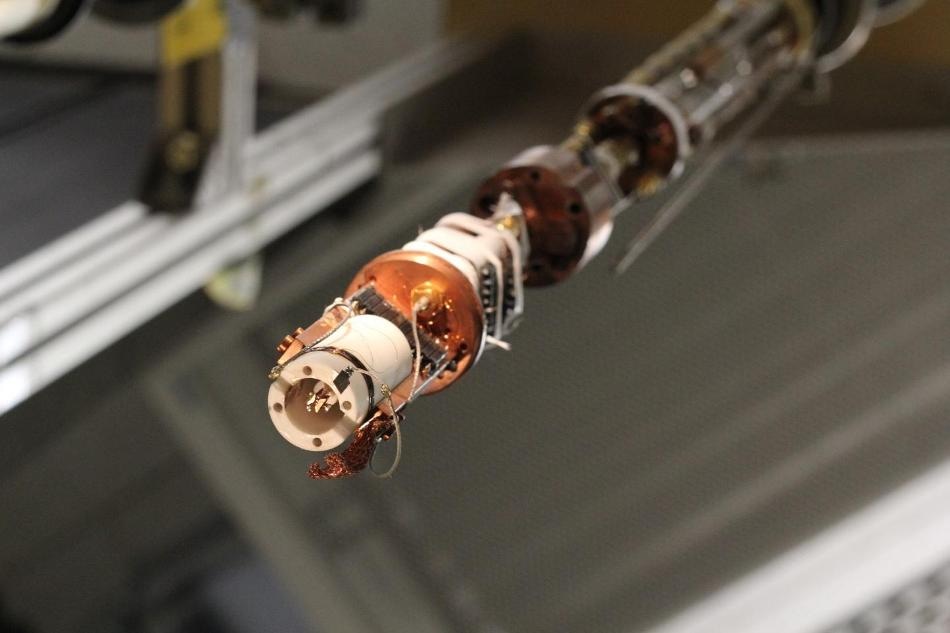Dec 10 2018
In general, magnetism and the lossless flow of electrical current, or “superconductivity,” are two conflicting phenomena that cannot coexist in the same sample.
 This is a scanning tunneling microscope installed in a helium cooling device seen from below (with the sample stage removed). The mechanism for positioning the microscope tip above the sample surface is visible (center of image). (Image credit: Simon Diesch)
This is a scanning tunneling microscope installed in a helium cooling device seen from below (with the sample stage removed). The mechanism for positioning the microscope tip above the sample surface is visible (center of image). (Image credit: Simon Diesch)
Yet, when it comes to developing supercomputers, it is highly advantageous to synergetically combine both states as compared to existing semiconductor technology, which is under reigning pressure because of its high power consumption and ensuing heat production.
Currently, scientists from the Department of Physics at the University of Konstanz have shown that it is feasible to achieve the lossless electrical transfer of magnetically encoded information. This discovery allows improved storage density on integrated circuit chips and, simultaneously, considerably reduces the energy consumption of computing centers. The outcomes of the study have been reported in the latest issue of Nature Communications, a scientific journal.
Miniaturization of the semiconductor technology is reaching its physical limits. For over seven decades, information processing in computers has been achieved by the production and transfer of electrical signals, requiring energy which is then liberated as heat. This dissipation leads to an increase in temperature in the building blocks, which, consequently, requires complex cooling systems. One of the major difficulties in miniaturization is heat management. Hence, at present, worldwide attempts are on to reduce waste heat in data processing and telecommunication.
At the University of Konstanz, a collaboration between the experimental physics team headed by Professor Elke Scheer and the theoretical physics team headed by Professor Wolfgang Belzig applied a strategy based on dissipation-free charge transport in superconducting building blocks. Usually, magnetic materials are used for information storage. In principle, it is also possible to transport magnetically encoded information without heat production by tapping the magnetic properties of electrons—the electron spin. Fundamentally innovative functionalities for future energy-efficient information technologies can be realized by combining the lossless charge transport of superconductivity with the electronic transport of magnetic information—that is, “spintronics.”
The researchers from the University of Konstanz are dealing with a major difficulty in relation to this strategy: the fact that in traditional superconductors, pairs of electrons with opposite magnetic moments carry the current. Hence, these pairs are nonmagnetic and do not have the ability to carry magnetic information. On the contrary, since the magnetic state is formed by magnetic moments aligned in parallel to each other, superconducting current is suppressed.
“The combination of superconductivity, which operates without heat generation, with spintronics, transferring magnetic information, does not contradict any fundamental physical concepts, but just naïve assumptions about the nature of materials,” stated Elke Scheer. Latest discoveries indicate that when superconductors are brought into contact with unique magnetic materials, it would be possible to bind electrons with parallel spins to pairs that carry the supercurrent through magnets over longer distances. This concept might enable innovative electronic devices with advanced properties.
Under the supervision of Elke Scheer, Dr Simon Diesch carried out an experiment that clarifies the mechanism of creation of such electron pairs that have parallel spin orientation. “We showed that it is possible to create and detect these spin-aligned electron pairs,” explained Simon Diesch. The system’s design and the interpretation of the measurement results are dependent on the doctoral thesis of Dr Peter Machon in the area of theoretical physics, which was performed under the supervision of Wolfgang Belzig.
“It is important to find materials that enable such aligned electron pairs. Ours is therefore not only a physics but also a materials science project,” stated Elke Scheer. The custom-made samples containing aluminum and europium sulfide were offered by researchers from the Karlsruhe Institute of Technology (KIT). Aluminum is a very well analyzed superconductor, thus allowing a quantitative comparison between theory and experiment. Europium sulfide is a ferromagnetic insulator, which is a material property significant for realizing the theoretical concept, thus retaining its magnetic properties even in very thin layers of only a few nanometers thick as used in this study. The scientists used a scanning tunneling microscope built at the University of Konstanz to carry out spatially and energetically resolved measurements of the charge transport of the aluminum-europium sulfide samples at low temperatures. In contrast to commercial instruments, the scanning tunneling microscope based at the Scheer lab has been optimized for utmost energy resolution and for operation in differing magnetic fields.
The dependence of the charge transport through the samples on voltage points toward the energy distribution of the electron pairs and enables accurate determination of the composition of the superconducting state. For this purpose, a theory developed earlier by the Belzig group and customized to describe the aluminum-europium sulfide interface was used. This theory will allow the scientists to characterize a lot more complex electrical circuits and samples in the future. The energy spectra estimated by the theory are in agreement with the experimental findings, offering direct proof of the magnetic electron pairs.
Moreover, the experimental-theoretical collaboration offered a solution to prevalent contradictions in relation to the interpretation of such spectra. The physicists from the University of Konstanz hope to use these outcomes to unearth the high potential of superconducting spintronics for improving or replacing semiconductor technology.